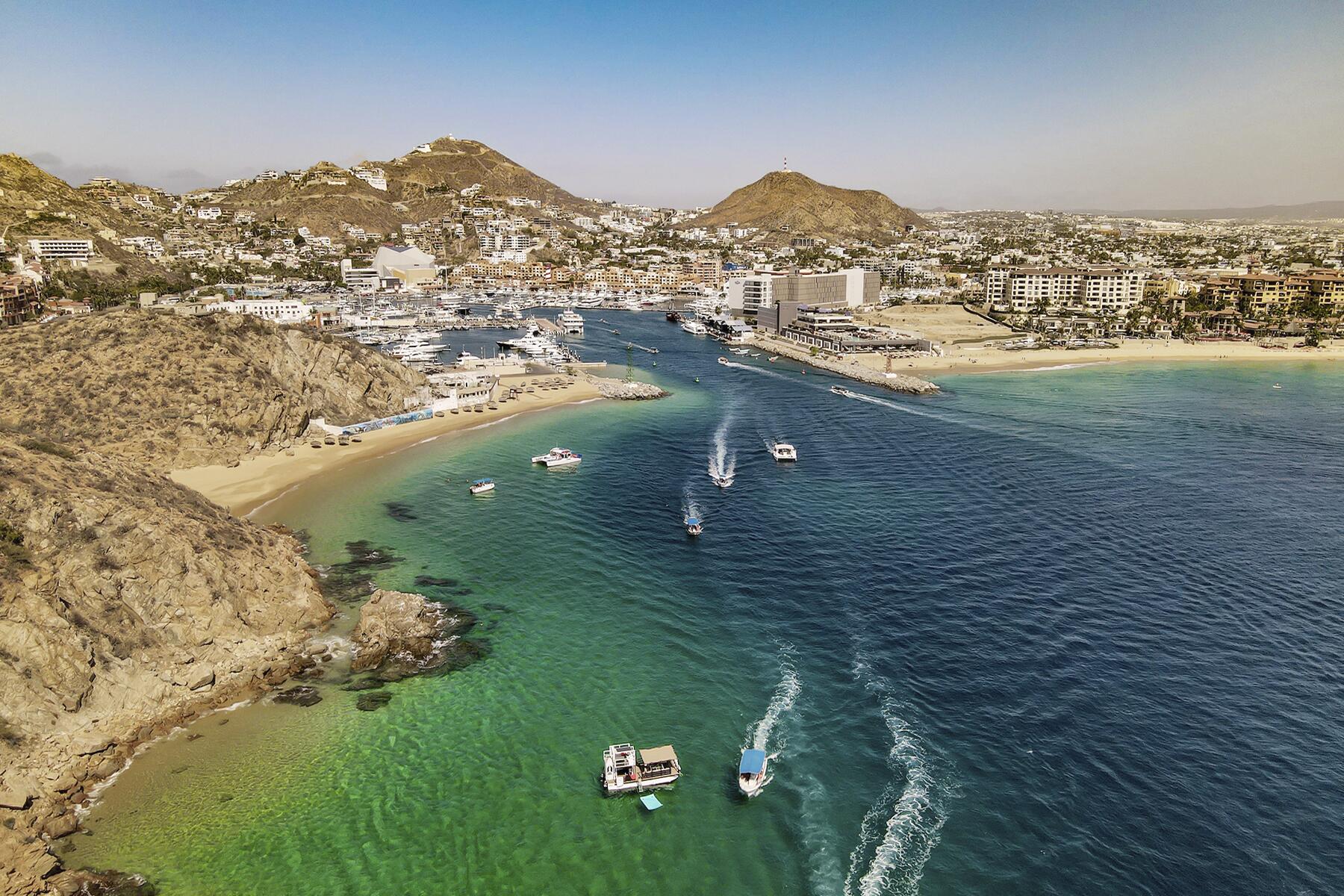Cabo San Lucas and San José del Cabo? Here’s how to dive into the dual personalities of this dazzling Mexican destination.
Los Cabos is collectively referred to as “The Marlin Capital of the World,” but it’s actually two distinct cities in the Baja California Peninsula: Cabo San Lucas and San José del Cabo. Linked by a stretch of highway known as the Tourist Corridor, these dual delights serve as bookends to a region with rugged beaches and desert landscapes.
Cabo San Lucas, the livelier of the two, sways to the rhythm of crashing waves by day and the pulse of nightlife after sunset. To the east, the pace slows in San José del Cabo, which has a stronger cultural heartbeat. Whether you’re drawn by the allure of big-game fishing, superlative spas, or championship golf courses, here is everything you need to know about The Capes in Baja California Sur.

Cabo San Lucas Is the Life of the Party
Cabo San Lucas is the more extroverted sibling and a magnet for those looking to inject a dose of adrenaline into their vacation with natural highs from outdoor activities or dusk-till-dawn hedonistic pursuits. Legendary nightlife spots like El Squid Roe and Cabo Wabo Cantina in the downtown area (Centro) have been tempting partygoers for decades. The latter was founded by Van Halen frontman Sammy Hagar in 1990, and it still plays host to an annual debauchery-leaning shindig in honor of his birthday. When the party’s over, revelers can snooze at accommodations that are generally more wallet-friendly than those in San José del Cabo, as it is exceedingly popular with the spring break crowd.
Recommended Fodor’s Video
Cabo San Lucas also has a scintillating selection of lively feet-in-the-sand cantinas where the young and the young at heart soak up the sun and savor local and international flavors. The Office on the Beach and Mango Deck are two such establishments on Playa Médano, the city’s main beach and ground zero for water sports.
The marina district is a bustling hub of activity for everything from deep-sea fishing charters to handicraft stores spilling over with Mexican crafts. Luxury Avenue and Puerto Paraíso malls cater to those looking to part with their pesos, while waterfront dining at Solomon’s Landing or Baja Cantina offers views as sumptuous as the meals gracing the menu.
The marina is also packed with boats waiting to whisk away whale watchers and sun worshippers to obligatory pit stops like the iconic Land’s End (El Arco), where the Sea of Cortez meets the Pacific Ocean. This confluence of waters creates an incredibly rich marine environment, making the region a world-renowned spot for deep-sea fishing enthusiasts. Between December and April, boats ply the waters around Cabo San Lucas for whale-watching tours, also departing from the marina.
Further adding to the city’s outdoor allure, golfers will find world-class golf courses on which to practice their swing in the form of Diamante and the 7,085-yard Quivira course, which have both found their way onto Golf Digest’s coveted list of the World’s 100 Greatest Golf Courses.

San José Del Cabo Is the Cultural Soul
San José del Cabo is the serene sibling of The Capes, with historical architecture and a thriving art scene. Throughout the year, the town comes alive with cultural festivals celebrating everything from music and film to food and traditional Mexican holidays.
The historic center is a walkable maze of Spanish-style buildings, quaint boutiques, and the iconic San José mission church in Plaza Mijares, and it is home to numerous galleries that showcase local and international talents. The weekly Art Walk that’s held every Thursday between November and June (from 5 pm to 9 pm) transforms the cobblestone streets into a canvas of color and creativity, inviting all to wonder and wander from post to post while mingling with the artists.
There is a sustainable alfresco dining idyll in San José del Cabo called Ánimas Bajas. This lush enclave has three renowned working farms where diners are invited for farm-to-table meals, tours, and classes that delve into the roots of Baja cuisine. Acre and Tamarindos double as hotels, while Flora Farms organizes movie nights (summertime only) and informative walks around the property with an herbalist, and there is a spa farm encircled by papaya trees.
Land activities that are popular in San José del Cabo include hiking, golfing, rappelling, and ziplining at Canopy Costa Azul. Water babies snorkel and swim at Costa Azul and Playa Acapulquito, and surfers find adequate conditions on these beaches between May and October.

The Tourist Corridor Is the Glue That Binds the Two
Spanning the 20-mile coastline that links Cabo San Lucas and San José del Cabo, the Tourist Corridor is a destination in its own right with a variety of uber-opulent hotels, scenic golf courses, and elegant shopping destinations like The Shoppes at Palmilla, where tequila lovers combine visits to Clase Azul’s La Terraza restaurant with retail therapy.
The Corridor also has several serene and swimmable beaches (not all beaches in Los Cabos are safe for swimming). Having a car is advantageous for hopping between the likes of El Tule, Palmilla, Chileno Beach, and the horseshoe-shaped Santa Maria Bay for dips.
Camera-ready resorts along this sandy corridor include Montage Los Cabos (the home of Los Cabos’ largest spa), Chileno Bay Resort & Residences, Grand Velas Boutique Los Cabos, and The Cape, a Thompson Hotel at Playa Monumentos, which has a destination rooftop with heart-tugging views of endless blues below and beyond.



